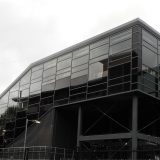
GG Glass has successfully completed a large scale curtain wall installation along the central front elevation of Limehouse Station, London, in rapid time.
Description
As part of Dockland’s Light Railway’s (DLR) proposals to increase passenger capacity and ease congestion for travellers interchanging with National Rail services, the London branch of GG Glass has removed and replaced a vast curtain wall system at Limehouse Station within just three weeks.
Working under a fast track programme with client Dyer and Butler from early design stage, GG Glass engineered a fit for purpose glazing solution based on a number of key factors including structural stability, aesthetics, ease of installation, wind load, thermal expansion and water diversion.
Installations of this size and scale would typically take between 5 – 6 weeks, however, due to the clients pressing timescales, the GG Glass team delivered the installation in just under half that time.
John Kim of GG Glass explained: “Our biggest challenge on this project was the installation timescales as we would generally allow considerably longer for a project of this scale, however, due to the clients pressing target date, with careful planning, we achieved this in three weeks. With an in-house team of specialists in design and installation, we were able to deliver a high quality and professional service, meeting all of our client’s objectives.”
 A Senior Architectural Systems SF52 curtain wall system was specified under the programme, for its high thermal performance and excellent weather performance as well as aesthetics, design flexibility, lightweight material, transparency, thermal performance and structural performance. This system also offered the client the flexibility to create a variety of unusual shapes rather than a traditional linear appearance.
A Senior Architectural Systems SF52 curtain wall system was specified under the programme, for its high thermal performance and excellent weather performance as well as aesthetics, design flexibility, lightweight material, transparency, thermal performance and structural performance. This system also offered the client the flexibility to create a variety of unusual shapes rather than a traditional linear appearance.
At 38000mm width x 4500mm height, the curtain wall combined various shapes and sizes using a 17.5mm toughened PVB laminated glass. Polyester powder coated to RAL colour 7012 Anthracite grey to a 60-micron thickness was chosen for the frame finish.
The area was closed off to the public through the installation period, however, the station remained fully operational through the contract period.
To view the full PDF of this case study, please click here.

